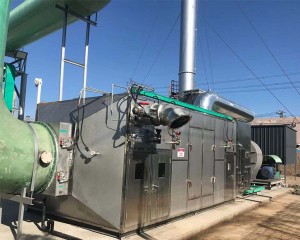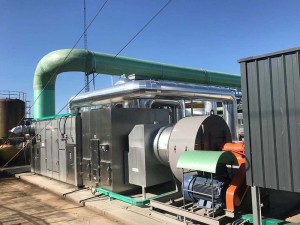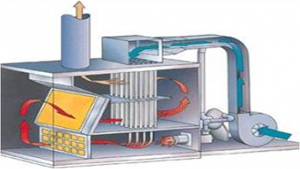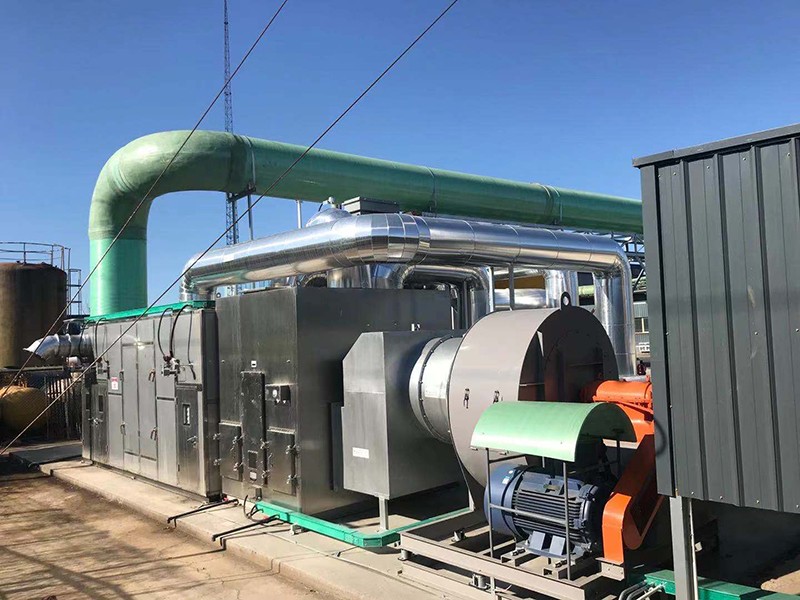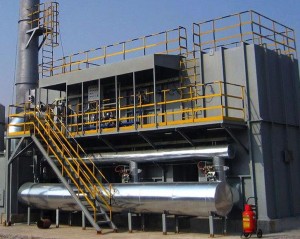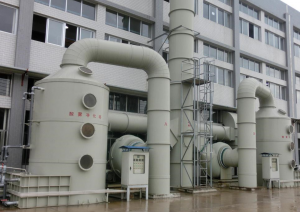LH-VOC-CO
Product detail
Purpose and scope
Industry application: common pollutants emitted by petrochemical, light industry, plastics, printing, coatings and other industries.
Application of waste gas types: hydrocarbon compounds (aromatics, alkanes, alkenes), benzenes, ketones, phenols, alcohols, ethers, alkanes and other compounds.
Principle of operation
The organic gas source is introduced into the heat exchanger of the purification device through the induced draft fan, and then sent to the heating chamber. The heating device makes the gas reach the catalytic reaction temperature, and then through the catalyst in the catalytic bed, the organic gas is decomposed into carbon dioxide, water and heat. , The reacted gas then enters the heat exchanger to exchange heat with the low-temperature gas, so that the incoming gas is warmed up and preheated. In this way, the heating system only needs to realize the compensation heating through the automatic control system, and it can be completely burned. This saves energy, and the effective removal rate of exhaust gas reaches more than 97%, which meets the national emission standards.
Technical characteristics
Low energy consumption: the catalytic light-off temperature is only 250~300℃; the preheating time of the equipment is short, only 30~45 minutes, the energy consumption is only the fan power when the concentration is high, and the heating is automatically intermittently compensated when the concentration is low. Low resistance and high purification rate: The honeycomb ceramic carrier catalyst impregnated with precious metals palladium and platinum has a large specific surface area, a long service life, and is renewable. Waste heat reuse: Waste heat is used to preheat the exhaust gas to be treated and reduce the power consumption of the entire host. Safe and reliable: The equipment is equipped with a fire-resisting and dust-removing system, an explosion-proof pressure relief system, an over-temperature alarm system and a fully automatic control system. Small footprint: only 70% to 80% of similar products in the same industry. High purification efficiency: The purification efficiency of the catalytic purification device is as high as 97%. Easy to operate: the system automatically controls when working.
How do we select right equipment ?
|
Specifications and Models |
LH-VOC-CO-1000 |
LH-VOC-CO-2000 |
LH-VOC-CO-3000 |
LH-VOC-CO-5000 |
LH-VOC-CO-8000 |
LH-VOC-CO-10000 |
LH-VOC-CO-15000 |
LH-VOC-CO-20000 |
|
|
Treatment air flow m³/h |
1000 |
2000 |
3000 |
5000 |
8000 |
10000 |
15000 |
20000 |
|
|
Organic gas concentration |
1500~8000mg/㎥(mixture) |
||||||||
|
Gas temperature of preheating |
250~300℃ |
||||||||
|
Purification efficiency |
≥97% (按GB16297-1996标准执行) |
||||||||
|
Heating power kw |
66 |
82.5 |
92.4 |
121.8 |
148.5 |
198 |
283.5 |
336 |
|
|
Fan |
Type |
BYX9-35№5C |
BYX9-35№5C |
BYX9-35№5C |
BYX9-35№6.3C |
BYX9-35№6.3C |
BYX9-35№8D |
BZGF1000C |
TBD |
|
Treatment air flow ㎥/h |
2706 |
4881 |
6610 |
9474 |
15840 |
17528 |
27729 |
35000 |
|
|
Air flow pressure Pa |
1800 |
2226 |
2226 |
2452 |
2128 |
2501 |
2730 |
2300 |
|
| Rotating speed
rpm |
2000 |
2240 |
2240 |
1800 |
1800 |
1450 |
1360 |
||
|
Power kw |
4 |
5.5 |
7.5 |
11 |
15 |
18.5 |
37 |
55 |
|
|
Equipment Size |
L(m) |
1.2 |
1.2 |
1.45 |
1.45 |
2.73 |
3.01 |
2.6 |
2.6 |
|
W(m) |
0.9 |
1.28 |
1.28 |
1.54 |
1.43 |
1.48 |
2.4 |
2.4 |
|
|
H(m) |
2.08 |
2.15 |
2.31 |
2.31 |
2.2 |
2.73 |
3.14 |
3.14 |
|
|
Pipe |
□(mm) |
200*200 |
250*250 |
320*320 |
400*400 |
550*550 |
630*630 |
800*800 |
850*850 |
|
○(mm) |
∮200 |
∮280 |
∮360 |
∮450 |
∮630 |
∮700 |
∮900 |
∮1000 |
|
|
Net Weight(T) |
1.7 |
2.1 |
2.4 |
3.2 |
5.36 |
8 |
12 |
15 |
|
Note: If the required air volume is not listed in the table, it can be designed separately.
Project case
Tianjin XX Food Co., Ltd. is engaged in the production and sale of food additives, biological fermentation, anthranilic acid products and related fine chemical products. It is one of the five saccharin manufacturers approved by the Chinese Government.
The project belongs to the food industry. During the production process, the waste gas sources are born in the first workshop, the second workshop, the sodium cyclamate workshop, the hazardous waste warehouse and the tank area. The waste gas concentration is ≤400mg per m³, and the organic waste gas reaches 5800Nm³ per hour. For organic mixed gas with high air volume, low concentration and low temperature, the "zeolite rotor + catalytic combustion CO" process is adopted. The features of this process are safety, reliability, and high treatment efficiency.


